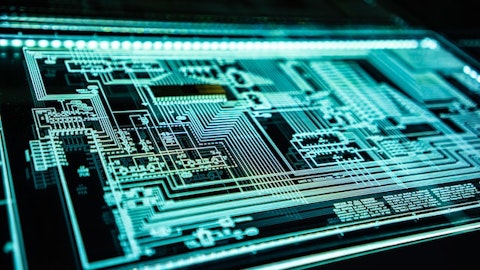which will contribute to revenue in 2025 and beyond. So we have a rollout of products. We’re pleased with the progress. We started to ship the SPD hubs and temperature sensor with ample and we’re working on the client rollout of products. And all of these should start contributing substantially more substantially in the second half of 2024.
Mehdi Hosseini: Great. And 1 follow-up for that. your Q4 guide implies OpEx of $50 million, taking the midpoint. And what I want to better understand is — how should we think about the scaling of OpEx once the revenue starts to grow once DDR5 RC or buffer chip start shipping. Can you manage the business with the $50 million to $51 million of OpEx as you scale revenue? Or would the OpEx would need to increase?
Desmond Lynch: Thanks for your question. I think as a company, we’ve done a very nice job in managing our expenses given the softer macroeconomic outlook. In Q3, our operating expenses were around $52 million were down from $58 million in Q1, which shows a discipline and focus on managing our expenses. In Q4, you are right that our OpEx spend will come down roughly to $50 million to $51 million for the quarter. What I would say is that we’ve highlighted when we divested the PHY IP businesses that we talked about reinvesting some of the R&D back into product programs, which will drive revenue into 2025 and beyond. And Luc talked about some of the client opportunities earlier. Looking at 2024, and what I would say from an R&D perspective, our spend historically has been around 23% to 25% of revenue.
And I would expect to be within that sort of range going forward. In SG&A, we’ll continue to be disciplined with inflationary type of increases here. And what you will see is some very nice leverage as we continue to grow the sort of, I think overall, we’ve managed our OpEx very well, which has really struck the right balance of being prudent to our short-term expenses and also balancing the need to invest in the long-term opportunities from there. So that’s how we see the OpEx playing out, Mehdi.
Operator: Our next question is from Kevin Cassidy with Rosenblatt Securities.
Kevin Cassidy: Congratulations on the strong quarter. Just as we talk about the DDR5, and I think you had mentioned sampling or qualifying the next generation. Is there an opportunity, you had mentioned about ASP are with the next generation, does it — is there a reset on ASP as you go to Gen 2, Gen 3 and so forth?
Desmond Lynch: Kevin, thanks for your question. What we see is that when we look ahead to the next sort of generation of we will see that ASP reset with each generation the generations of DDR5 are coming around quicker. They seem to be on a 12-month cadence just now compared to the sort of 24 months cadence under DDR4 that will offer the opportunity of an ASP reset from there. What I would say is that we’ve been very disciplined in our approach to sort of pricing and we have a really good track record of producing healthy product gross margins. And as I mentioned earlier, this year, we’re going to our product gross margins to be around 62% to 63%, which is in line with the midpoint of our long-term product gross margin range of 60% to 65%.
Kevin Cassidy: Okay, great. And just on the HBM3 device — or that IP, are you recognizing revenue for that? Or did you recognize revenue in the September quarter? Or is it part of your December quarter guidance?
Luc Seraphin: HBM3 announcement we’ve made is an IP that we’ve just announced at the top end of speeds in the 9.6-giga tranfers per second. So this is a product to come that will contribute to revenue in the future. It’s not a product that has generated revenue this quarter or next quarter.
Kevin Cassidy: Okay. I see. I wasn’t sure if it was — if you had a beta customer that already had developed.



